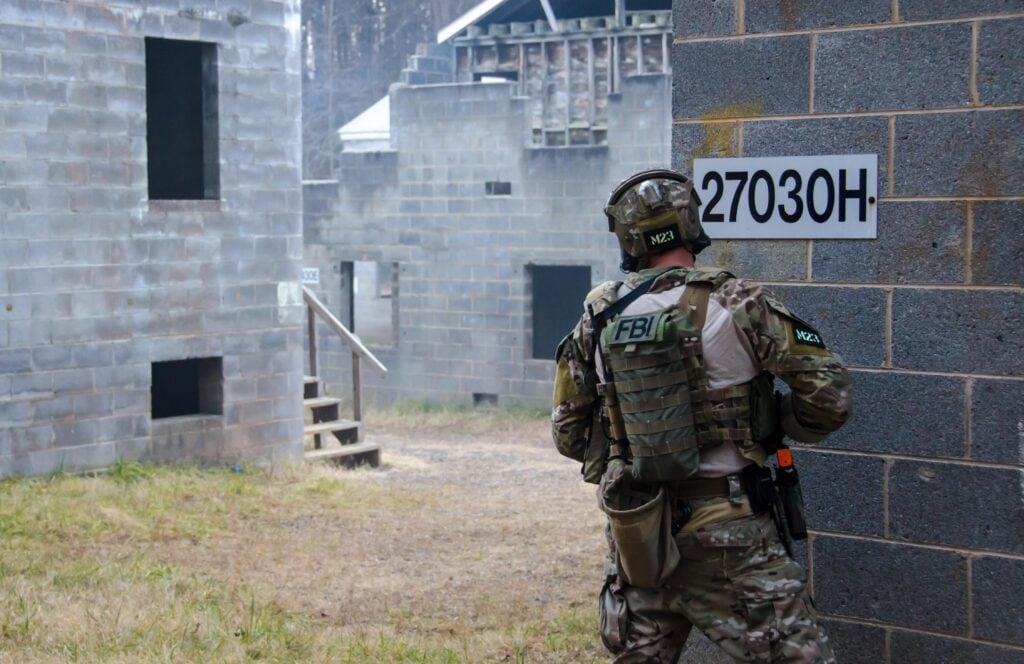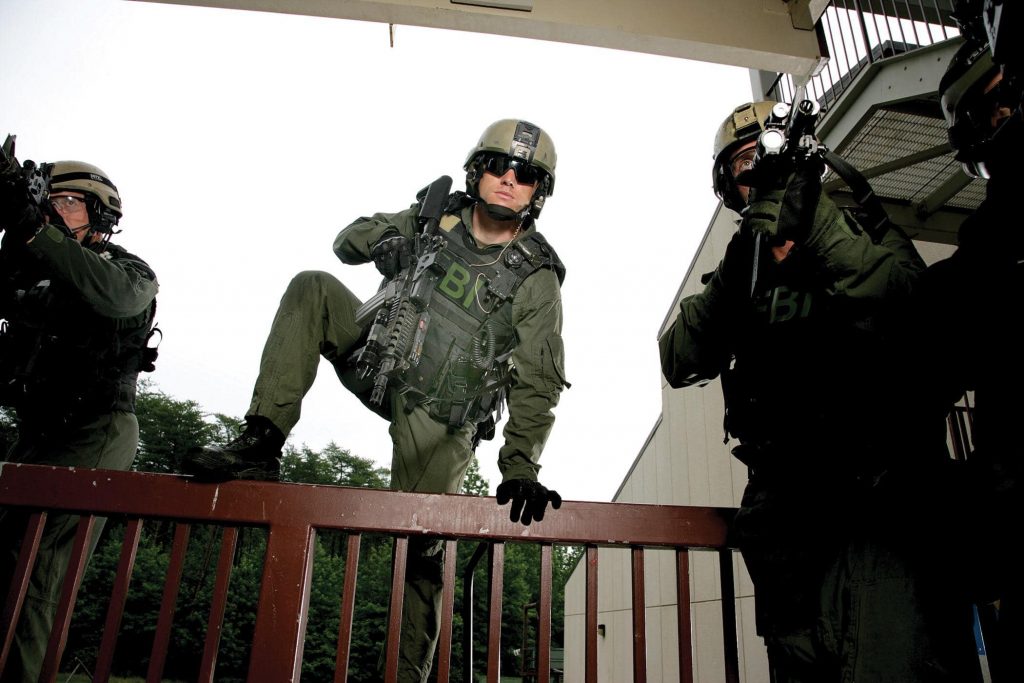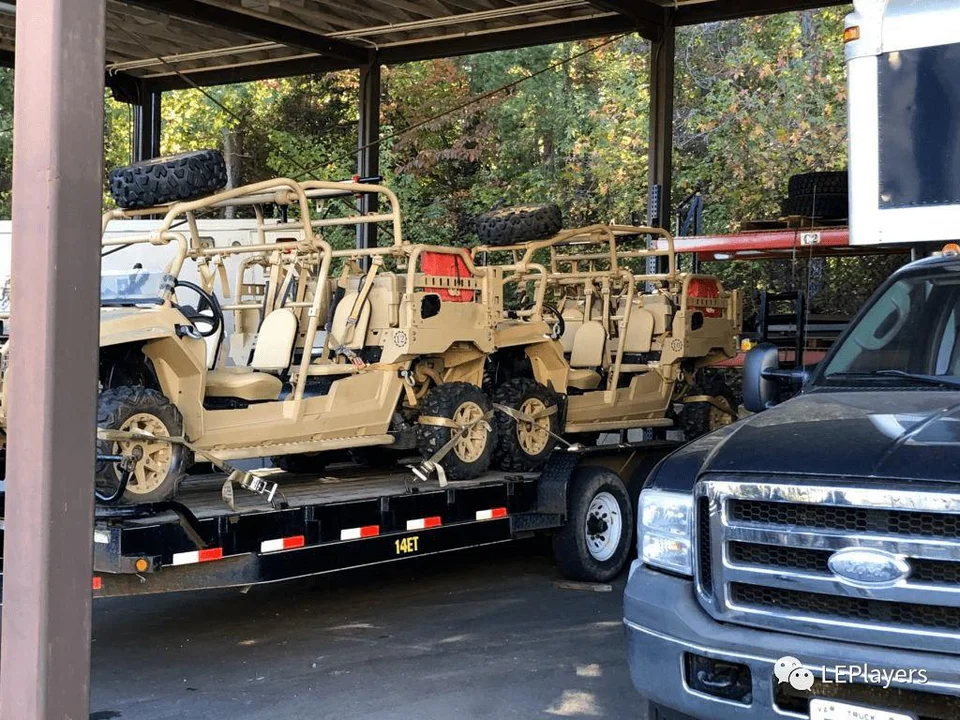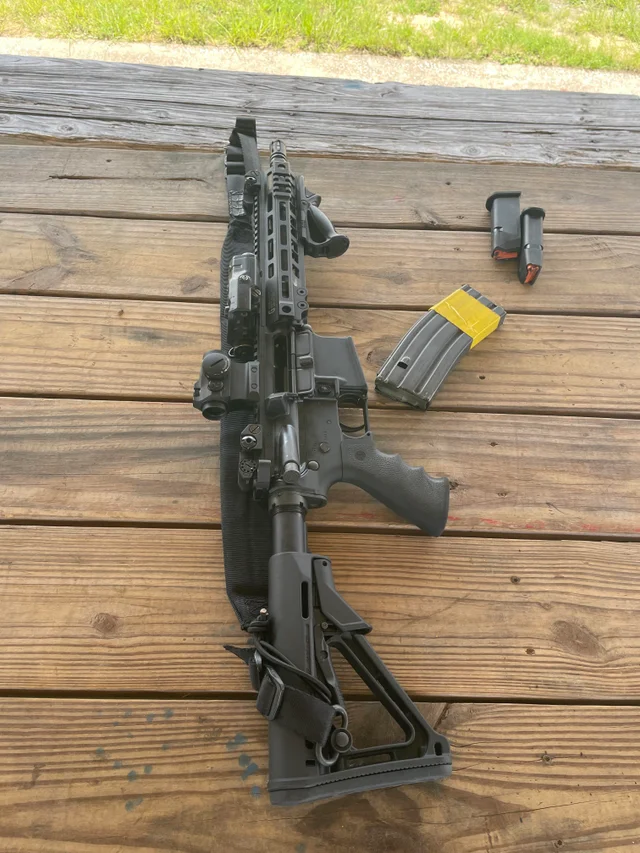FBI Hostage Rescue Teams (HRT)

The FBI HRT (Hostage Rescue Team), is the first hostage rescue team in the United States and was founded with the help of Delta Force aka Combat Applications Group (CAG) and sometimes referred to as "Domestic Delta".
The world is constantly changing, over the past 50 years the proliferation of non-state actors has made small teams of highly specialized elite soldiers a must for all armies on the planet. The various special mission units of the United States Army Joint Special Operations Command are the tools that the United States uses to fight against terrorist organizations abroad.
At the national level, the Federal Bureau of Investigation (FBI) is responsible for preventing and combating terrorism within the borders of the United States. The FBI's Hostage Rescue Team (HRT) is the Bureau's response to the increase in hostage takings and terrorist attacks in the United States. Known for their motto Servare Vitas, To Save Lives, their specialty in hostage rescue and counter-terrorism operations makes them the most effective team available to the FBI. Its objective is to react quickly and solve critical situations related to the rescue of hostages and domestic terror.

1. FBI HRT Doctrine
The purpose of the HRT is multifaceted given its variety of disciplines, but it is primarily the FBI's primary counter-terrorism and hostage rescue unit.
The HRT specializes in being one of the fastest response components of the FBI's Critical Incident Response Group, being able to respond to hostage and terror situations, primarily in a domestic setting. They use the tactics of many other US special operations groups, training alongside groups such as Delta Force and the FBI's regional SWAT teams. ( Source ).
Their skills in close quarters combat, sniping, room clearing and rapid breaching are combined with their extreme mobility and adaptability to make them an elite tool for the FBI.
2. FBI HRT History
The HRT was founded in response to the rapidly changing nature of global security and the threats posed to the United States both domestically and abroad. The team itself was born in the aftermath of the 1972 and 1984 Olympic Games. During the 1972 Olympics, Palestinian terrorists kidnapped nine Israeli athletes after killing two others. In a shootout with German authorities, all hostages and terrorists were killed. ( Source )
When the United States was selected to host the 1984 Olympics, the FBI was tasked with creating a team capable of carrying out counterterrorism operations and preventing a similar hostage-taking. ( Source ) In 1983, the HRT officially completed its extensive training. Such training involved creating firefights, exploring theoretical tactical situations, reacting quickly to hostage situations, and coordinating with other elements of the FBI such as their regional SWAT teams. ( Source ) It culminated in the conduct of a counter-terrorism training exercise where HRT countered a nuclear terrorist threat alongside SWAT and the FBI's Nuclear Emergency Support Team (NEST). ( Source )

2.1. Post '83 THS
Since its creation and its first deployment in 1983 and 84', HRT has broadened its technical skills by training alongside other teams. ( Source ) Delta Force in particular was an important factor in the formation of the HRT, with Delta's tactical skills motivating the FBI to have a team of equivalent caliber.
In 1994, it became a component of the Critical Incident Response Group (CIRG). Since becoming a component of the CIRG, it has operated alongside other U.S. defense and law enforcement elements as a rapid response tactical team. ( Source )
The September 11 attacks would further increase the importance of counter-terrorism teams and greatly expand the reach of HRT beyond the national domain. It would begin operating, and still does today, alongside other US forces, in addition to its homeland security objective. ( Source )
3. Organization
As of January 2020, there were a total of 149 full-time service crew members on the HRT. ( Source ) According to the information available on the team composition, they have two operational teams: Gold Team and Blue Team. Within these teams are specialists who draw from the myriad of disciplines used by HRT, such as assault, sniping, hostage rescue, counter-terrorism and counter-hijacking operations. ( Source )
In addition to their internal organization, their tactical composition may change depending on their mission and the other teams they work with. The FBI HRT can work alongside virtually any special operations team or special task force, whether at home or abroad. Their operational composition changes according to the parameters of the mission.
3.1. Selection
The selection for the HRT is similar to that of many US special operations forces. Applicants must be highly experienced and seasoned individuals with relevant skills in order to be considered for selection. Minimum qualifications for the team include: ( Source )
- Be a US citizen.
- Be able to obtain Top-Secret clearance.
- Possess a driver's license.
- Commit to a three-year contract as a special agent.

Additional requirements include ongoing drug testing, polygraph examinations, credit and background checks, and FBI interviews. ( Source ) These requirements come from the requirements of the FBI as a whole, which influences the requirements of each of its specialized teams.
After selection, HRT trainees will follow the physical and tactical training necessary to become operators.
3.2. Coaching
The training for the HRT takes place in two different contexts, in a preparatory phase for new operators and continuously after the end of the training.
New operators organize a large battery of training courses. Physical conditioning is one of the first components. This includes things like long distance runs, forced marches, obstacle courses, full training, and full marches. ( Source ) Operators in extreme working conditions for their extremely physically demanding work. This physical training, alongside other training in the entry phase, lasts approximately six months before the trainees move on to the next phase of training.

After completing the initial training phase, HRT members move on to more specialized training. Depending on the specialization of each team member, they can train with different special ops groups. Maritime operators for example will complete phase 2 of BUD/S with Navy Seal candidates. (Source) (Source) Candidates with previous sniper experience or likely to undergo follow-up training as snipers.

HRT also participates in exchange programs with various special operations units, including Delta Force, DEVGRU, DEA FAST team, Border Patrol BORTAC units, and police CERT teams. These teams contribute to building the essential and variable skills that HRT needs to fully meet its objectives.

4. Tactics, Techniques, Procedures (TTP)
The unique skills of HRTs allow them to be reliably available and able to deal with any threat. His most notable tactics and procedures include hostage rescue tactics, marksmanship, rapid deployment, counter-diversion tactics, and tactical site surveying.
Hostage rescues add an extra layer of complications to a standard operation. Teams enter, sweep and clean tight spaces while considering hostage safety. The HRT trains and trains regularly in a number of different tactics including: ( Source )
- CQB General Combat.
- Provide tactical cover for unarmed personnel.
- Neutralize and/or apprehend barricaded or fortified fighters.
4.1. snipers
Marksmanship is just as important to HRT tactics as its CQB skills. Snipers, often trained by Delta Force and other specialist sniper teams, provide a long-range solution to HRT missions. HRT snipers and other FBI spin-off teams must learn to coordinate with the tactical teams attacking the objective. They also learn negotiation and intelligence gathering and exploitation tactics. Typically, they act as the most forward element, gathering information through observation and can engage in negotiations if the situation calls for it. ( Source ) Snipers are capable of tracking multiple targets, defensive and precision shooting tactics over long distances . ( Source )
4.2. Mobility team
One of the pillars of the HRT is its ability to deploy in a given situation in 4 hours. This is supported by the team's high standards of personal preparedness, but also by the effective use of rapidly deployable vehicles such as helicopters. HRT members are able to fast rope, allowing them to perform quick tactical action once they arrive. ( Source ) Training alongside specialized air teams allows the HRT to become even more proficient in deploying via rapid response vehicles.

Tactical site surveying is a very important skill of HRT. It allows HRT teams to conduct a functional tactical analysis of a target building or area, in preparation for a break-in attack. It is also used to create a red team for installations in the United States and on foreign bases. The skill is useful in a live tactical setting, but can also be applied to defensive preparations.
5. FBI HRT Equipment
In conjunction with the team's rapid response objective, HRT vehicles enable teams to arrive quickly and efficiently. For their two support elements, the Tactical Helicopter Unit and the Tactical Mobility Team, there is a range of air and ground vehicles that can be employed by the HRT: ( Source )
Tactical Helicopter Unit:
- Bell 412EP.
- Bell 407.
- UH-60M Black Hawk.
- MD 530.
Tactical Mobility Team:
- Chevy pickups with modified assault scales.
- Chevy Suburban 4x4.
- HMMWV (Humvee) vehicles.
- VBL II Bison and Coyote APC.
- Chenowth Desert Patrol Vehicle / Light Strike variant / Advanced Light Strike.
- Polaris MRZR.
Each of these vehicles gives the HRT the speed, responsiveness and edge it needs to be able to respond to a crisis situation. Without vehicles supporting HRT operations and deployment, it would be much less adaptable and effective.

5.1. Weapons
The HRT's arsenal is similar to that of special operations groups, in that it varies greatly depending on the mission. Sniper rifles and CQB weapons are prioritized in the majority of missions, however, the arsenal is much more extensive. HRT weapons include, but are not limited to, the following: ( Source ) ( Source )
Assault Rifles:
- HK416
- M4A1 carbine
- Mk 18
- HRT carbine
Submachine guns:
- MP5/10A3
- MP5SD6
Shotguns:
- Benelli M4.
- Remington model 870.
Sniper rifles:
- HKMSG90
- Remington Model 700
- M107 clip
- GA Precision FBI HRT Rifle
Machine guns:
- M249
- Mk46
- Mk 48
Guns:
- Glock 19M
- Glock 26
- Glock 23
- 2011
- 1911
5.1.1. The HRT rifle
During the Global War on Terror (GWOT), many special operations teams fell in love with the Mk 18. The Mk 18 is a shortened version of the M4 carbine. The weapon has undergone some modernizations since its creation in the late 1990s. However, he has been a mainstay on the battlefield due to his compact size, which makes him perfect for close combat. This is probably where the HRT got their inspiration for their custom carbine for their attackers.
5.1.1.1. Rifle Details
The HRT carbine is visually similar to the Mk 18 mod 1. However, the discerning observer will notice a few key differences. The Mk 18 uses a 26.1 cm (10.3 in) barrel, while the HRT carbine uses a 29.2 cm (11.5 in) barrel. This is done for two main factors: reliability and lethality. The slightly longer barrel increases the dwell time of the rifle. There is more space between the gas port and the muzzle, leaving more gas in the system than the Mk 18. In addition, the longer barrel increases the pressure behind the bullet, allowing it to reach a speed higher before exiting the barrel. These two factors result in a more reliable and lethal weapon than an MK18 while sacrificing minimal compactness.


The rifle also uses a unique handguard produced by Geissele Automatics. Geissele has long been a producer of high quality triggers and accessories for SOCOM and manufactures the new improved Upper Receiver Group (URG-I). HRT's handguard is known as Federal Rail and comes in a drab olive color for HRT. Other federal law enforcement agencies use similar rifles, but they have gained the most notoriety through their use by HRT. The rail combines standard machined 1913 rails with M-LOK modular attachment points, allowing the user to add lights, lasers, and grips at their discretion.
6. Notable FBI HRT Operations
6.1. Waco Headquarters
Waco is an event that had a profound impact on America, raising questions about freedom, authority, and the seemingly inevitable clash between the two. For the FBI and especially the HRT, the event is both a lesson in tactics and optics.
The siege of the Branch Davidian compound occurred with the memory of Ruby Ridge fresh in the minds of the FBI and the American public. Attacking a compound with over 70 potentially armed and fanatical fighters is by no means an easy task. HRT's Blue and Gold teams were the best the FBI could muster to deal with such a problem.
6.1.1. Worse and worse
After negotiation, elements of the HRT attempted a more diplomatic solution, and there seemed to be potential for peace as 19 children were released. ( Source ) It wasn't until Koresh, the leader of the Branch Davidians declared that God was keeping him within, that the siege took a much more forceful turn. The HRT launched a frontal attack, using gas in an initial attempt to eliminate the cultists. The ensuing panic and exchange of weapons caused fires around the compound. ( Source )

Amid the fires, gunfire and collapsing buildings, 76 Branch Davidians were killed, including unarmed women and children who burned to death as a result of the blaze. Additionally, 4 ATF agents died. The siege ended in a tragic loss of life that severely damaged the reputation of the HRT, ATF, and FBI as a whole. The HRT would be used in a number of future operations, although with more oversight despite this apparent failure
6.2. Talladega Prison Riot
Given the scale of the American prison system, it is unfortunately inevitable that some prisons will lose control of their population, some even to a catastrophic level. The riot at FCI Talladega was such a situation.
Faced with the inevitable deportation and the harsh conditions in the prison, on August 21, 1991, the 121 inmates of the federal establishment revolted. The resulting riot led to the inmates taking over the prison and taking a number of prison guards hostage. ( Source )
The HRT was tasked with ending the crisis when the FBI Director and his constituents learned that inmates had discussed killing prison guards. It was not a long operation, just as the HRT planners had anticipated. The team entered using shaped charges to force open the doors, overpowered many inmates, and freed the guards with no casualties. ( Source )
The operation was a great success and a great juxtaposition to the events in Waco, with the HRT fulfilling its operational requirements with no fatalities on either side.
6.3. Colleyville Synagogue Hostage Crisis
The Colleyville hostage crisis is both a success and a failure. It is difficult to judge the success of a hostage situation even in the face of freed hostages, and Colleyville is such a case.
On January 15, 2022, Mailk Akram took four hostages at the Congregation Beth Israel synagogue. His motive was the release of Aafia Siddiqui, a Pakistani woman imprisoned in Fort Worth. ( Source ) Following the deployment of HRT and other FBI elements, a siege began.
Eventually, the HRT was deployed with lethal force, for increased fear of civilian casualties. The HRT task force entered the synagogue, threw several stun grenades, then entered the room where Akram and the hostages were. Akram was killed by HRT gunfire and all hostages were rescued. ( Source )
6.3.1. The following
This is, by definition, a success for HRT. However, compared to the events at Talladega and Waco, Colleyville is perhaps a different lesson for future HRT missions. A lesson that lies between the two previous events. The hostages were indeed rescued, however, Akram's murder leaves his motives unclear. If he had lived, we might have better understood his intentions, his motivations and his machinations. This too should be considered with many hostage or active fire situations, where ending the threat may be the priority, but also comes with the downside of less information once the situation is resolved.
When the United States has such a proficient asset as the HRT to respond to such situations, perhaps it should consider that the highest lethality route, as in Waco and Colleyville, may not be the one which offers the most long term solutions to such situations. situations.
7. Summary
The HRT and other forces within the FBI will continue to grow in their capabilities and the scope of their operations. Their skill, though demanding temperance in the most dangerous situations, is unmatched in their discipline. It's safe to say that if a hostage situation spirals out of control or a domestic terrorist attack is detected, HRT will only be hours away.
0 comments